
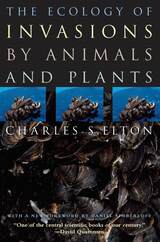
Elton explains the devastating effects that invasive species can have on local ecosystems in clear, concise language and with numerous examples. The first book on invasion biology, and still the most cited, Elton's masterpiece provides an accessible, engaging introduction to one of the most important environmental crises of our time.
Charles S. Elton was one of the founders of ecology, who also established and led Oxford University's Bureau of Animal Population. His work has influenced generations of ecologists and zoologists, and his publications remain central to the literature in modern biology.
"History has caught up with Charles Elton's foresight, and The Ecology of Invasions can now be seen as one of the central scientific books of our century."—David Quammen, from the Foreword to Killer Algae: The True Tale of a Biological Invasion
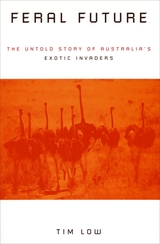
Australia is far from alone in facing horrific ecological and economic damage from invading plants and animals, and in Low's capable hands, Australia's experiences serve as a wake-up call for all of us. He covers how invasive species like cane toads and pond apple got to Australia (often through misguided but intentional introductions) and what we can do to stop them. He also covers the many pests that Australia has exported to the world, including the paperbark tree (Melaleuca) that infests hundreds of thousands of acres in south Florida.

Threatening the complete collapse of the fishery, the sea lamprey invasion triggered an environmental awakening in the region and prompted an international treaty that secured unprecedented cooperation across political boundaries to protect the Great Lakes. Fueled by a pioneering scientific spirit, the war on Great Lakes sea lampreys led to discoveries that are the backbone of the program that eventually brought the creature under control and still protects the largest freshwater ecosystem in the world to this day.
Great Lakes Sea Lamprey draws on extensive interviews with individuals who experienced the invasion firsthand as well as a trove of unexplored archival materials to tell the incredible story of sea lamprey in the Great Lakes—what started the invasion, how it was halted, and what this history can teach us about the response to biological invaders in the present and future. Richly illustrated with color and black & white photographs, the book will interest readers concerned with the health of the Great Lakes, the history of the conservation movement, and the ongoing threat of invasive species.
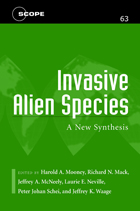
Invasive alien species are among today's most daunting environmental threats, costing billions of dollars in economic damages and wreaking havoc on ecosystems around the world. In 1997, a consortium of scientific organizations including SCOPE, IUCN, and CABI developed the Global Invasive Species Programme (GISP) with the explicit objective of providing new tools for understanding and coping with invasive alien species.
Invasive Alien Species is the final report of GISP's first phase of operation, 1997-2000, in which authorities from more than thirty countries worked to examine invasions as a worldwide environmental hazard. The book brings together the world's leading scientists and researchers involved with invasive alien species to offer a comprehensive summary and synthesis of the current state of knowledge on the subject.
Invasive alien species represent a critical threat to natural ecosystems and native biodiversity, as well as to human economic vitality and health. The knowledge gained to date in understanding and combating invasive alien species can form a useful basis on which to build strategies for controlling or minimizing the effects in the future. Invasive Alien Species is an essential reference for the international community of investigators concerned with biological invasions.
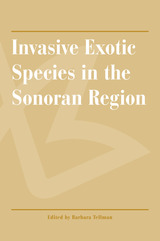

Invasive Species in a Changing World brings together leading scientists from around the world -- including Carla M. D'Antonio, Jeffrey McNeely, Robert Sutherst, David Richardson, and others -- to examine the invasive species phenomenon and to consider the mutual interactions between global change and invasives that are likely to occur over the next century. Invasive Species in a Changing World: offers a comprehensive look at the status of freshwater, marine, and terrestrial ecosystems in relation to invasives; examines physical factors that will influence the future success ofinvading species; considers the tools available to track changing patterns and movements; looks at human dimensions including human health effects, and effects on crops; describes the problem in different parts of the world.
Contributors focus on the proposition that global change will exacerbate the invasive species problem, and set forth the idea that invasives are themselves a global change element that need to be considered in global change scenarios.
Invasive Species in a Changing World provides readers with the background and knowledge they need to begin developing strategies to combat the invasive species problem, and is essential reading for anyone concerned with the impact of invasive species on ecosystem health and functioning.
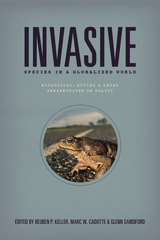
Yet even though ecological research has led to public conversation and policy recommendations, those recommendations have frequently been ignored, and the efforts to counter invasive species have been largely unsuccessful. Recognizing the need to engage experts across the life, social, and legal sciences as well as the humanities, the editors of this volume have drawn together a wide variety of ecologists, historians, economists, legal scholars, policy makers, and communications scholars, to facilitate a dialogue among these disciplines and understand fully the invasive species phenomenon. Aided by case studies of well-known invasives such as the cane toad of Australia and the emerald ash borer, Asian carp, and sea lampreys that threaten US ecosystems, Invasive Species in a Globalized World offers strategies for developing and implementing anti-invasive policies designed to stop their introduction and spread, and to limit their effects.
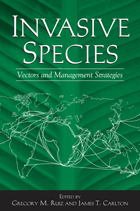
Recent years have seen a steep rise in invasions of non-native species in virtually all major ecoregions on Earth. Along with this rise has come a realization that a rigorous scientific understanding of why, how, when, and where species are transported is the necessary foundation for managing biological invasions.
Invasive Species presents extensive information and new analyses on mechanisms of species transfer, or vectors, as the latest contribution from the Global Invasive Species Programme (GISP). Contributors assess invasion vectors and vector management in terrestrial, freshwater, and marine ecosystems for major taxonomic groups in a variety of regions around the world. The book:
- examines invasion causes, routes, and vectors in space and time
- highlights current approaches and challenges to preventing new invasions, both from a geographic and taxonomic point of view
- explores strategies, benefits, and limitations of risk assessment
- offers a synthesis of many facets of vector science and management
- presents recommendations for action
Chapter authors review fungi, plants, invertebrates, and vertebrates, with geographic assessments covering New Zealand, Australia, South Africa, and the United States.
Although the full extent and cumulative impact of nonnative species can only be approximated, biological invasions are clearly a potent force of global change, contributing to a wide range of deleterious effects including disease outbreaks, habitat alteration and loss, declines of native species, increased frequency of fires, and shifts in nutrient cycling. Vectors are the delivery mechanisms, resulting in recent increases in rates of new invasions. Invasive Species brings together in a single volume new information from leading scientists around the world on approaches to controlling and managing invasion vectors. This volume is a timely and essential reference for scientists, researchers, policymakers, and anyone concerned with understanding biological invasions and developing effective responses to them.
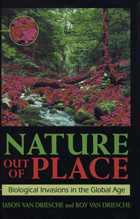
Though the forests are still green and the lakes full of water, an unending stream of invasions is changing many ecosystems around the world from productive, tightly integrated webs of native species to loose assemblages of stressed native species and aggressive invaders. The earth is becoming what author David Quammen has called a "planet of weeds."
Nature Out of Place brings this devastating but overlooked crisis to the forefront of public consciousness by offering a fascinating exploration of its causes and consequences, along with a thoughtful and practical consideration of what can be done about it. The father and son team of Jason and Roy Van Driesche offer a unique combination of narratives that highlight specific locations and problems along with comprehensive explanations of the underlying scientific and policy issues.
Chapters examine Hawaii, where introduced feral pigs are destroying the islands' native forests; zebra mussel invasion in the rivers of Ohio; the decades-long effort to eradicate an invasive weed on the Great Plains; and a story about the restoration of both ecological and human history in an urban natural area. In-depth background chapters explain topics ranging from how ecosystems become diverse, to the characteristics of effective invaders, to procedures and policies that can help prevent future invasions. The book ends with a number of specific suggestions for ways that individuals can help reduce the impacts of invasive species, and offers resources for further information.
By bringing the problem of invasive species to life for readers at all levels, Nature Out of Place will play an essential role in the vital effort to raise public awareness of this ongoing ecological crisis.
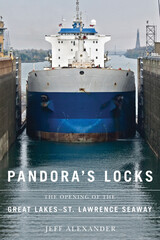
The St. Lawrence Seaway was considered one of the world's greatest engineering achievements when it opened in 1959. The $1 billion project-a series of locks, canals, and dams that tamed the ferocious St. Lawrence River-opened the Great Lakes to the global shipping industry.
Linking ports on lakes Superior, Michigan, Huron, Erie, and Ontario to shipping hubs on the world's seven seas increased global trade in the Great Lakes region. But it came at an extraordinarily high price. Foreign species that immigrated into the lakes in ocean freighters' ballast water tanks unleashed a biological shift that reconfigured the world's largest freshwater ecosystems.
Pandora's Locks is the story of politicians and engineers who, driven by hubris and handicapped by ignorance, demanded that the Seaway be built at any cost. It is the tragic tale of government agencies that could have prevented ocean freighters from laying waste to the Great Lakes ecosystems, but failed to act until it was too late. Blending science with compelling personal accounts, this book is the first comprehensive account of how inviting transoceanic freighters into North America's freshwater seas transformed these wondrous lakes.
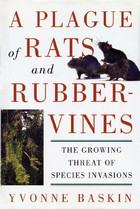
The human love of novelty and desire to make one place look like another, coupled with massive increases in global trade and transport, are creating a growing economic and ecological threat. The same forces that are rapidly "McDonaldizing" the world's diverse cultures are also driving us toward an era of monotonous, weedy, and uniformly impoverished landscapes. Unique plant and animal communities are slowly succumbing to the world's "rats and rubbervines" -- animals like zebra mussels and feral pigs, and plants like kudzu and water hyacinth -- that, once moved into new territory, can disrupt human enterprise and well-being as well as native habitats and biodiversity.
From songbird-eating snakes in Guam to cheatgrass in the Great Plains, "invasives" are wreaking havoc around the world. In A Plague of Rats and Rubbervines, widely published science writer Yvonne Baskin draws on extensive research to provide an engaging and authoritative overview of the problem of harmful invasive alien species. She takes the reader on a worldwide tour of grasslands, gardens, waterways, and forests, describing the troubles caused by exotic organisms that run amok in new settings and examining how commerce and travel on an increasingly connected planet are exacerbating this oldest of human-created problems. She offers examples of potential solutions and profiles dedicated individuals worldwide who are working tirelessly to protect the places and creatures they love.
While our attention is quick to focus on purposeful attempts to disrupt our lives and economies by releasing harmful biological agents, we often ignore equally serious but much more insidious threats, those that we inadvertently cause by our own seemingly harmless actions. A Plague of Rats and Rubbervines takes a compelling look at this underappreciated problem and sets forth positive suggestions for what we as consumers, gardeners, travelers, nurserymen, fishermen, pet owners, business people -- indeed all of us who by our very local choices drive global commerce -- can do to help. "
READERS
Browse our collection.
PUBLISHERS
See BiblioVault's publisher services.
STUDENT SERVICES
Files for college accessibility offices.
UChicago Accessibility Resources
home | accessibility | search | about | contact us
BiblioVault ® 2001 - 2024
The University of Chicago Press









